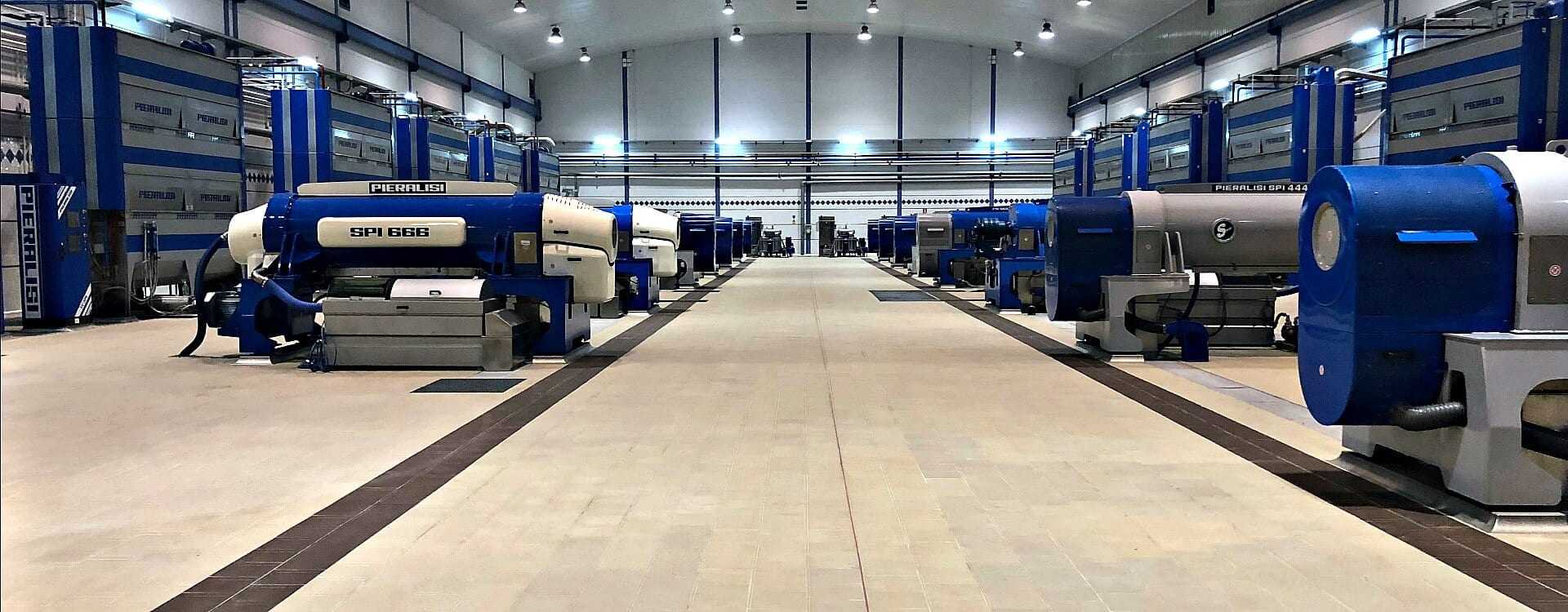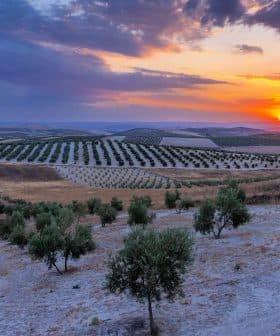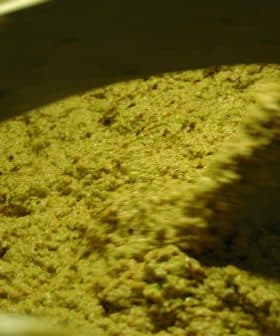How Olives Are Processed Into Oil
Modern technology has replaced traditional methods, from crushing olives to the final extraction process.
 33.6K reads
33.6K readsAdvancements in technology have revolutionized the process of extracting olive oil, allowing producers to tailor the transformation process to their specific needs and achieve high-quality results. Traditional stone grinders have been replaced by sophisticated electronically-controlled milling equipment, which limits exposure to oxygen and preserves the healthy and organoleptic properties of the oil. The incorporation of state-of-the-art technology has paved the way for the increasing quality of olive oil production, with ongoing research and developments aiming to further improve quality, productivity, and efficiency in a sustainable manner.
Extracting oil from the fruit of the olive tree is a complex process, a challenge faced by the people of the Mediterranean for thousands of years.
Today, highly sophisticated electronically-controlled milling equipment quickly replaces the large stone grinders used for centuries to crush olive drupes.
While these traditional mills are still widely used, the sector’s continued efforts to achieve the optimal organoleptic characteristics and health properties have seen the technology used to produce olive oil change rapidly.
The technology behind the milling process
The incorporation of state-of-the-art technology has paved the way for the increasing quality of olive oil production.
Producers can now tailor the transformation process to their specific needs, altering operating times, temperatures, atmospheric composition, etc.
“Without these advancements, we would not have the extraordinarily high quality of our olive oils,” Furio Battelini, the technical director of Agraria Riva del Garda, told Olive Oil Times.
See Also:Olive Oil Basics“Much technology is yet to be developed, but it exerts a crucial role,” he added. “Whoever aims at high quality in olive oil making needs to invest in it, try it out and find the best settings for their olives.”
Successfully producing the highest-quality olive oil heavily depends on agronomics, technology and the experience of trained technicians.
Whereas olive oil producers once harvested all their fruits at once to transform them at the end of the harvest, modern producers often deploy specific milling settings for the different olive varieties they grow.
They can now explore the ripening of the olive fruits to identify the perfect moment for transformation. Each cultivar is often harvested and transformed in separate moments.
First step: crushing the fruit
Once the olives reach the mill, the leaves left over from the harvest are mechanically removed, and the fruits are washed.
In traditional mills, olives are crushed with a procedure substantially unchanged for centuries: heavy grinders attached to a central column crush the fruits.
See Also:What Does Cold Pressed Really Mean?Modern mills use advanced machines with hammer breakers, blades or rotary disks, allowing for a quicker transformation of significantly larger amounts of olives.

A bank of malaxers (Photo: Museum.it)
Additionally, these tools greatly limit the exposition of the olives to oxygen compared to traditional methods, preserving their healthy and organoleptic properties.
Both crushing methods result in a raw olive paste made of the peel of the fruit, its pulp and fragmented pits. The paste also contains small olive oil drops and water, which is naturally contained in the olive drupes as they develop on the tree.
“This is one of the most delicate steps in olive oil making,” Battelini said. “Millers have to take into account the temperature of the olives themselves as they reach the mill.”
“If harvested on warmer days, such levels might easily exceed the 20 ºC to 22 ºC, which I consider the maximum to obtain a high-quality product,” he added.
Second step: kneading the olive paste
In a modern mill, the freshly-produced raw paste is transferred into the kneader, also called a malaxer.
The kneader is a tank equipped with blades that slowly stir the paste. The stirring process allows the blades to break up the water-oil emulsions created by the crushing.
Furthermore, the process allows larger drops of olive oil to form, easing their separation from water, a crucial advantage for the final extraction.
For the delicate process to succeed, the olive paste is gently warmed. Still, the kneading process temperature will never exceed 27 ºC in meeting the strict requirements for extra virgin olive oil.
The temperature is considered the perfect balance between protecting the best qualities of olive oil and the production needs.
Kneading completion times vary significantly depending on the type of machines being used, the amount of olives, their stage of ripeness and the production goals in terms of quantity and quality. “The shorter the time, the better if your goal is quality,” Battelini said.
Third step: olive oil extraction
In traditional mills, the raw paste is not subjected to kneading. Instead, it is carefully spread onto circular discs with a hole at the center.
Piles of these discs are slowly pressed together, separating the oil and water from the pulp, which remains on the discs.

Almazara Nuestra Señora del Pilar
Given the goals of high-quality production, modern olive milling has adopted new means of extraction, no longer based on pressing.
Oil extraction is now done with a decanter, or centrifuge, which spins very quickly to separate the oil in the paste from the water and pulp. Finally, the separated olive oil is transferred from the decanter into steel containers.
See Also:Filtered or Unfiltered Olive Oil? A Choice for ConsumersDepending on the machines’ specifics, olive oil coming out of the decanter might still contain traces of pulp, air or water.
Filtering equipment is often used to speed up a natural process that would separate the olive oil from those particles, obtaining olive oil ready to be bottled and consumed.
How to store freshly-produced olive oil
Since the domestication of the olive tree, producers have adopted a wide array of containers to store their olive oil. Terracotta amphorae were used for a long time throughout the whole Mediterranean.
Nowadays, glass and more modern materials, such as fiberglass and plastic, are used. Still, most extra virgin olive oil producers store their oil in stainless steel tanks capped with inert gas, such as nitrogen. Topping olive oil with an inert gas prevents oxidation.
The tanks are usually kept within a temperature range of 14 ºC to 18 ºC to preserve the olive oil’s healthy and organoleptic qualities. From there, olive oil may be bottled and distributed.
Alternative extraction methods: the Sinolea technology
An alternative olive oil extraction technique developed at the beginning of the last century is known as the Sinolea procedure, based on the surface tension properties of specific metals.
The goal is to separate olive oil from the other contents of the paste. Metal blades are immersed in the mix, and a natural adhering process will make the olive oil only stick to the metal.
After, the blade can be removed, and the oil it carries can be conveyed to a dedicated container.
In modern plants, the Sinolea method starts during kneading, where metal blades separate olive oil from the raw olive paste.
Milling techniques continue to advance
Modern technology has revolutionized the production of high-quality olive oil. Producers can quickly process large amounts of olives with advanced, electronically-controlled milling equipment while preserving their healthy and sensory properties.
However, research across the olive oil-producing world continues to improve quality, productivity and efficiency further while keeping sustainability in mind.
Know the Basics
Things to know about olive oil, from the Olive Oil Times Education Lab.
Extra virgin olive oil (EVOO) is simply juice extracted from olives without any industrial processing or additives. It must be bitter, fruity and pungent — and free of defects.
There are hundreds of olive varieties used to make oils with unique sensory profiles, just as many varieties of grapes are used in wines. An EVOO can be made with just one variety (monovarietal) or several (blend).
Extra virgin olive oil contains healthy phenolic compounds. Substituting a mere two tablespoons of EVOO per day instead of less healthy fats has been shown to improve health.
Producing high-quality extra virgin olive oil is an exceptionally difficult and costly task. Harvesting olives earlier retains more nutrients and extends shelf life, but the yield is far less than that of fully ripe olives that have lost much of their healthy compounds.
Share this article









